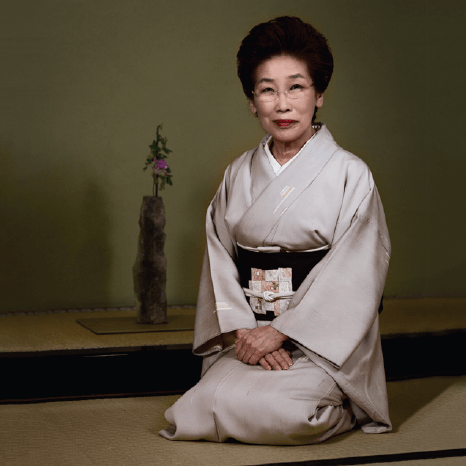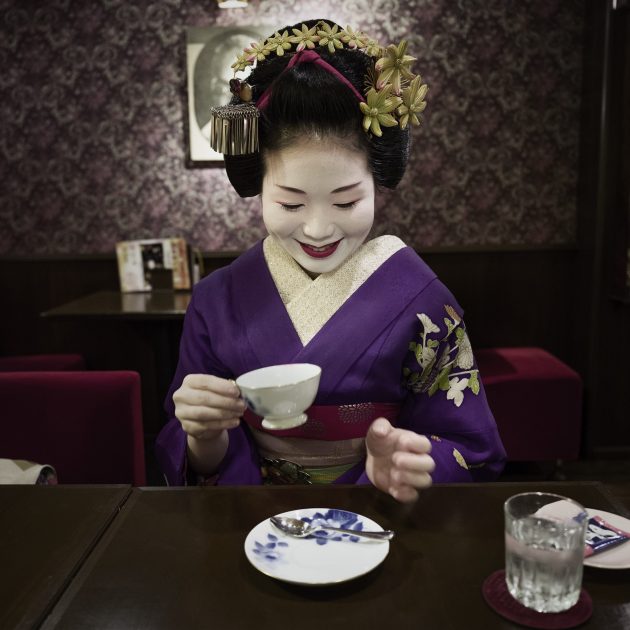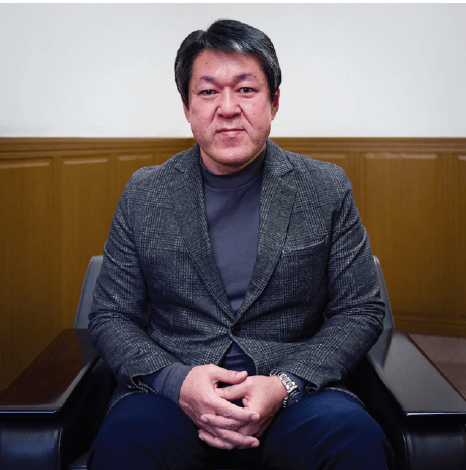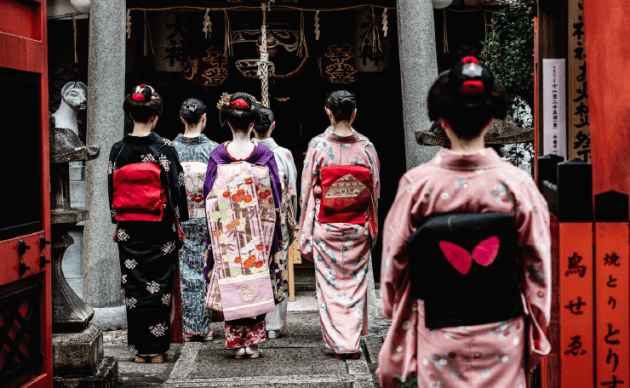I have a long-term interest in living traditional cultures and have often wondered: what does it take to keep traditions alive, authentic and thriving?
Glimpsing a maiko under her red bamboo umbrella, gliding by one evening in cobblestoned Kyoto, I was deeply impressed by her timeless elegance and strong presence. I soon realised that I had found an intriguing photographic project within an essentially private community of traditional artists, and the multiple layers of teachers, managers, artisans and guests who enable and support them. This would bring me back to Kyoto many times over the next four years, culminating in my book ‘Geiko and Maiko of Kyoto.’
To me a living culture is rooted firmly in a continuing cultural tradition and in a place. Without this deep rootedness, cultural practices may border on nostalgia or at worst a kind of ‘Disneyfication’. Those who devote years, decades and even generations to the world of maiko and geiko have, of course, made adaptations to Japan’s complex transition from feudal to modern society. A living culture evolves to survive, but retains its essence.

Toshikana as maiko
The Kagai as garden
The characters for kagai, Kyoto’s geiko districts (read as hanamachi elsewhere in Japan), are often translated as ‘flower town’. Early in my research I began exploring this metaphor of a garden for the kagai’s cultural ecosystem. I soon discovered that, as in gardens, there are many layers, perspectives and influences.
As well as specific geiko and maiko, officials and teachers are prominent in each of the five kagai. Hidden in plain sight within and nearby the kagai are some of the other crucial components associated with them, such as the artists and craftspeople who create the shoes, kimono, obi, fans and umbrellas, wigs, hairstyles and hair ornaments. Like Koichi Sakura from Gion Choboya, whose family has been making okobo, the high wooden shoes worn by maiko, for generations. They are made from very light paulownia wood, and each debuting maiko requires three pairs. Kanzashi, the exquisite hair ornaments, are worn to reflect the seasons and this too is a complex craft. Some kanzashi and pocchiri (obi brooches) are priceless antiques. Okasan, mothers of the okiya, the maiko/geiko house, are discerning curators of all aspects of costume and okamisan (mistresses of the ochaya or teahouse) understand who makes the best tea and the best sake as well as how to craft a fine seasonal banquet using local food providers.
Interviewing traditional business owners, I found that some were the last of many generations in that tradition since their children had chosen other careers. Too often they are also the last of a once-thriving industry as their competitors have gradually closed shop. This all reflects Japan’s social and economic trends as well as personal choices.

Toshikana of Komaya Teahouse, Miyagawa-cho, on the day of her erikae or induction
into a fully-fledged geiko.
I found a variety of perspectives on the fundamental aspects of these gardens. When asked ‘What are you in this garden?’ several replied that they were the soil. While the shamisen is well known as the musical ‘ground’ for dance performances, my friend, Akira Okamoto, the proprietor of Okazen kimono store, made a good case for kimono also being the soil.
Some of my favourite authors disagree as to what is the essence of geiko. Liza Dalby, author of the seminal work ‘Geisha’, considers that dance and odori (the annual dance and music performances) are of central importance. Kelly Forman in her ‘The Gei of Geisha: Music, Identity and Meaning’, sees shamisen music as the essence.
Forman uses the wonderful term, liminas, referring to people and professions that exist at the threshold or outside of the usual cultural categories. The image of geiko and maiko floating just outside the usual cultural roles, and even outside time, has certainly reverberated with me; they are not ‘like’ anything we know in the West and yet they have deep roots in Japanese history and tradition.
For Fumie Komai the essence is a certain Japanese spirit that is central, an attitude to service and traditional manners. As the mistress of the Komaya okiya and ochaya and CEO of the Miyagawa-cho Ochaya Association, she tells me: “The kagai is almost the only place maintaining these traditions.”
So I came to think of an interdependent living cultural system as central to the garden metaphor. A system with many parts, and where ‘the whole is greater than the sum of the parts.’ Interestingly, the kamon (heraldic symbol) of Miyagawa-cho is three interconnected rings, symbolizing the unity of the temples/shrines, townspeople, and teahouses.

Fumie Komai
Maintaining the garden
Senior geiko are essential for the development of the nuanced artistry and embodied grace of the authentic geiko. Like old growth trees in a forest they have a key role in the ecosystem and may need special care as they age. Although there are some geiko in their 70s, 80s and even 90s who still work, the cohort in their 50s and 60s is small, creating potential problems in ensuring skilled jikata (geiko singers and shamisen players) are available for dancers.
Retaining the continuity from maiko to senior maiko to geiko and senior geiko is a challenge in a dynamic modern society. Fumie Komai works creatively to present the work of geiko as a lifetime career. For example, she collaborates with maiko and their families to ensure those with an interest in music get access to specialised training. Yet after years of demanding training and long work hours they may feel the lure of family life and other careers. But, as she says, “You can’t stop them leaving.”
Hazunashi’s mother was a geiko, but sadly died soon after giving birth to her in Miyagawa-cho in 1935, and so her grandmother raised her and her sister. All the daughters living in the kagai began learning shamisen and traditional dance when they turned 6 years old, usually beginning on 6th June (auspiciously 6-6-6). Her older sister began training as a maiko when she was only nine years old, primarily learning by observation. After the war that system changed and maiko were required to complete high school and so Hazunashi started as a maiko when she was 18 years old.
When Hazunashi was young, seniors were very strict but she prefers to more gently encourage young maiko to embody the skills so they too can have a lifelong career as a geiko. She is open to a “throwing away of inefficient and unnecessary things” so long as the depth and heart of the tradition is maintained in a kind of distillation process. Geiko should have an interwoven set of all the traditional arts and that takes a lifetime; it takes three years of full time shamisen playing, just to stop looking at the strings.
Hazunashi observes that these days there is more emphasis on a geiko’s personality and individual strengths. Perhaps this relates to cultural shifts towards individualism as well as the increasing rarity of geiko. There are around 70 maiko and geiko in Miyagawa-cho now, compared with around 200 geiko in the 1950s when Hazunashi began in that kagai. Appreciation of the arts has risen since the 1950s and 60s and with it the numbers of maiko are stabilising in Kyoto.
Senior and older retired geiko need to be able to live within the kagai to have ongoing formal and informal input on training. The economics of independent geiko living near their kagai in apartments (yakata) risks becoming unworkable with gentrification, and associated airbnb and upmarket shops; subsidies by rich patrons are a thing of the past.

The English-speaking maiko Tomitsuyu of Tomikiku Teahouse, Gion Higashi
I have been interviewing Tomitsuyu regularly since she was a shikomi (a girl considering becoming a maiko). Now an accomplished senior maiko, she shares her deep sense of being a part of a tradition that dates back hundreds of years. She was delighted to have had a small speaking role in the most recent odori as it had an historical theme. It takes time for guests to appreciate the subtleties of traditional dance and music and to feel able to give specific feedback. She describes how important her long-term guests are, as they can notice and comment on her improving skills. Initially, because of her fluent English, she had a high number of Western guests who, of course, were largely novices themselves to this world. So it seems that the right mix of guests is important in encouraging skills as well as ensuring ongoing clientele.
I am reminded that gardens can be enjoyed and influenced by botanists, gardeners and garden lovers. The forest is more than the trees, however impressive. The debut visits of maiko and geiko to ochaya and other local businesses are not empty ritual. A senior maiko told me that flower shops were also important in the broader kagai system. Businesses give flowers to maiko, geiko and ochaya, who in turn give flowers to businesses on their openings and anniversaries. Mutual connections are constantly built and maintained, evidenced by the flowers outside businesses and name-cards and fans displayed inside them.

Saburo Nakanishi, CEO of Gion Higashi
Locating the garden
How important is place for this cultural ecosystem? Mr Saburo Nakanishi, CEO of Gion Higashi, explained that the kagai are only really responsible for the geiko, maiko and the people of the ochaya and okiya; beyond that they must rely on influence. The few remaining original buildings in his kagai are now jammed between unattractive multistorey buildings that carry dozens of signs for bars and nightclubs. Imagine a fun fair in a drab public park encroaching upon a small exquisite Japanese garden.
Despite this cultural clash, the kagai maintains its traditions. I witnessed the annual ritual at their local shrine involving the whole kagai, with senior geiko and okamisan performing the rituals inside, while maiko stand respectfully outside, the sole shikomi standing behind them. In other seasons I have seen them involved in street parades, parties and events in the wider traditional life of Kyoto, beyond the boundaries of their kaga. Mr Nakanishi also told me that their small numbers mean that they all work hard at their beautiful annual odori since everyone must participate in every performance and they must use musicians from beyond their own community.
Nearby, the larger Gion Kobu kagai enjoys wonderfully restored buildings, cobbled streets and no power lines. However this attracts hordes of tourists who, without benefit of appropriately skilled local guides, can remain poorly informed, (including believing fictional ‘geisha memoirs’). Sometimes they even ‘mob’ passing maiko, grabbing at their $25,000 ensembles, while demanding photographs! Maiko must run this gauntlet nightly and even their guests can struggle to get to the ochaya door. Yet traditional customers need to not be pushed out by tourists. When taxis and tourists are at their peak it makes sense to pedestrianize the main street in Gion, but only if customers can reach events, and maiko or geiko can safely access a taxi.

Annual visit to Kankame Shrine in Gion
Adapting to survive and surviving adaptions
A mature maiko or geiko offers us the complex experience of being in the presence of an exquisitely elegant traditional artist with impeccable skills so that we feel honoured, relaxed, entertained and slightly awed. These deep traditions need a conservative approach to change or they risk their treasures being lost to the forces of fad and fashion.
New developments and adaptions are often made by okamisan and kagai associations, as well as by individual independent geiko, though usually negotiated within their communities. These modifications are necessary for economic and cultural survival, especially now that the era of wealthy patrons is almost gone. Nowadays, the busy program of maiko and geiko can include travel for business or cultural events and even television or movie roles. Some kagai now have small exclusive ochaya bars, owned and run by jikata for members who prefer briefer visits or a less formal atmosphere. With suitable introductions (some hotel concierges may assist), some kagai also offer opportunities to those who are not members of an ochaya so they can enjoy a traditional banquet during which maiko and geiko visit to converse and perform.
Too few foreign tourists seem to know about or attend the extraordinary odori. Each kagai has its own theatre and has an annual performance series. Many times of the year there are public events involving maiko and geiko. Information about these options is available at sites such as www.kyotoguide.com or www.insidekyoto.com.
However, complex delicately balanced cultural ecosystems like the kagai, despite their adaptivity, can be seriously damaged in unintended ways. Planners need to stand ready to intervene when external forces threaten the kagai and exercise great caution when making or allowing any changes within and around the kagai.
The community and its economy clearly benefit from the income generated by the huge numbers of Japanese and foreign visitors attracted by Kyoto’s maiko and geiko. The kagai themselves weave long-term personal and professional relationships with members of their local community who directly and indirectly engage with their beautiful ancient art forms. To maintain such a special and complex ‘garden’ involves strong healthy plants, knowledgeable and dedicated gardeners, energy and nourishment, and appreciative and thoughtful visitors.

Author
Robert van Koesveld
Author's Bio
Robert van Koesveld gave up his career as a psychotherapist to become a full-time “travel and cultural photographer,” with particular interest in “the intersection of past and present”—as seen in his 2010 book Bhutan Heartland. His ‘Geiko and Maiko of Kyoto’ won the Canon–AIPP photo book of the year award in Australia in 2015. www.robertvankoesveld.com
Credits
All photographs by Robert van Koesveld


